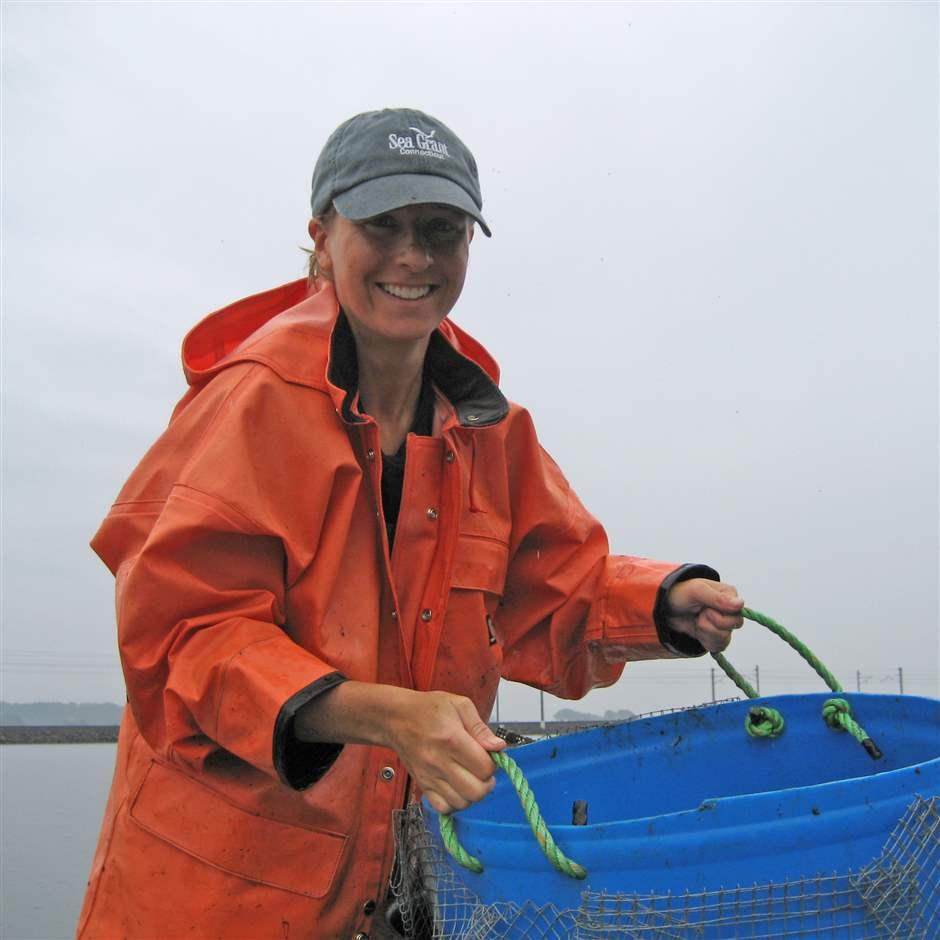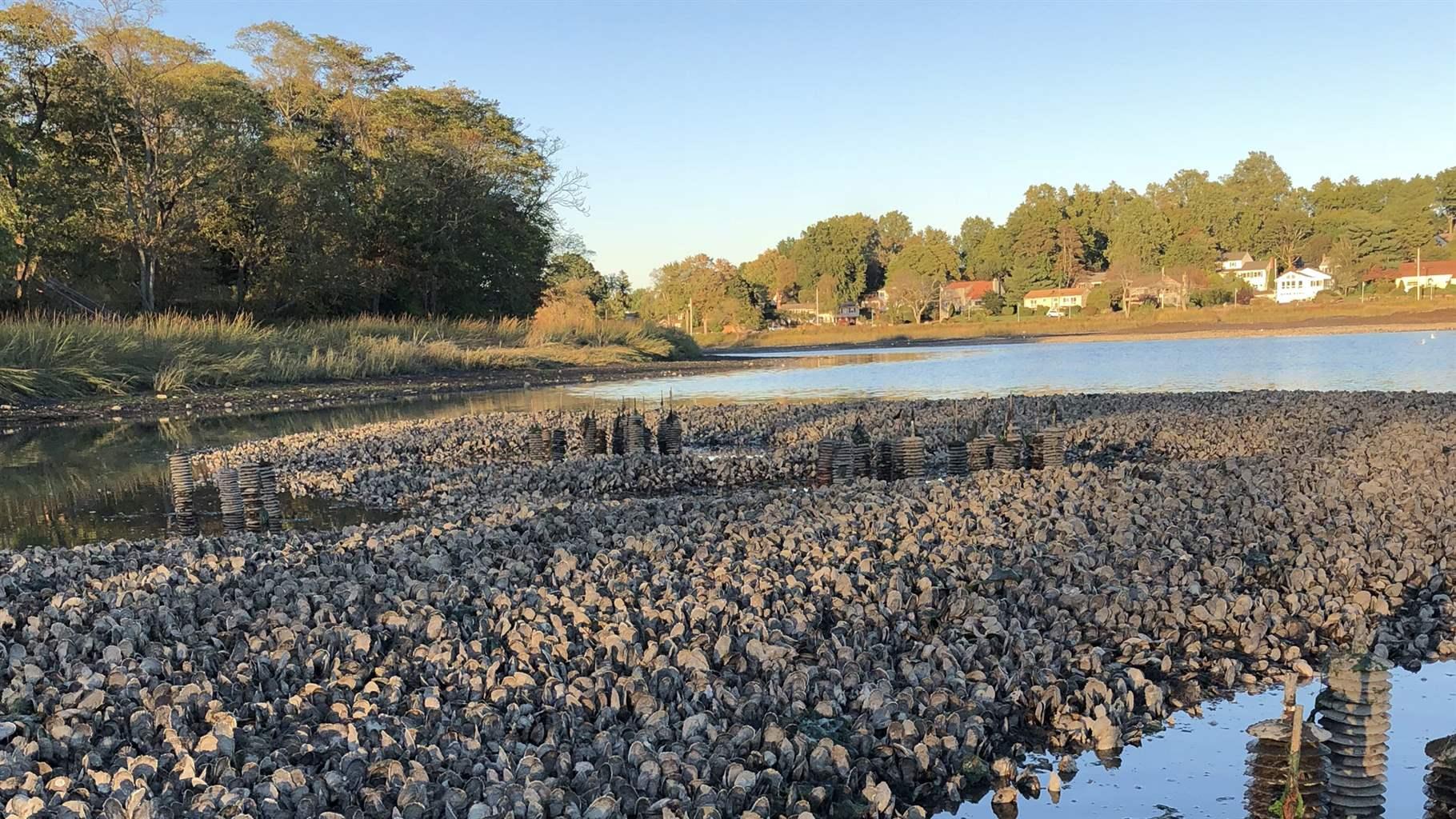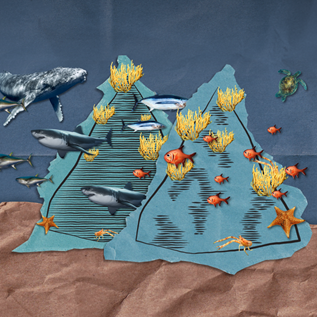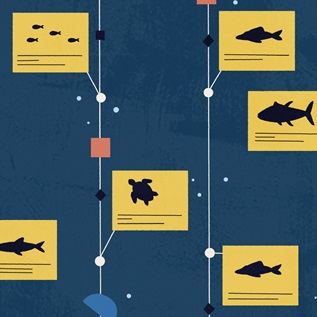A Small State Plans to Go Big With Oyster Restoration
A new science-based tool, the first of its kind, will help Connecticut rebuild its wild oyster beds
On this National Oyster Day, The Pew Charitable Trusts celebrates Connecticut’s ongoing efforts to rebuild its historic wild oyster beds. Earlier this year, Connecticut Sea Grant, a federal-academic partnership that works to achieve healthy coastal and marine ecosystems to benefit the public, collaborated with Connecticut’s departments of Agriculture and of Energy and Environmental Protection and the federal Natural Resources Conservation Service to release an online mapping tool to help scientists and conservationists select optimal locations for shellfish restoration projects. Tessa Getchis, an aquaculture specialist with Connecticut Sea Grant, worked with leaders throughout the state to help facilitate the development of the new tool. This interview has been edited for length and clarity.
Q: Do you remember discovering that you wanted to work on marine issues?
A: I wasn’t born a scientist, but thinking about how and why the ocean was changing sparked questions in my mind. I grew up about an hour from the Connecticut coast, and spent nearly every weekend on my family’s boat in Mystic. I fished and dug for clams with my sisters and cousins, and listened to my dad, who was a commercial fisherman in the 1970s, talk about the plants and animals we spotted in the water. I remember him talking about how the bunker [a small fish species formally known as Atlantic menhaden] that he would catch for bait were getting fewer and smaller. For years we picked mussels off the rocks, and then all of a sudden they weren’t there anymore.
Q: How did those early experiences translate into you becoming an aquaculture specialist?
A: My family always ate a lot of seafood, but I assumed it was all wild caught. My first experience with aquaculture came in college at Roger Williams University, where I volunteered with a graduate student who was experimenting with summer flounder aquaculture, and it hit me: “Wow, you can grow these fish!” So, I started wondering: What else were people growing? Understanding there were ways to grow fish and shellfish for food and even get them back in the ocean led me to change my path from marine biology to aquaculture. I went on to study aquaculture at the University of Rhode Island for my master’s degree, which I finished in 2000.
Q: And that eventually led you to Connecticut Sea Grant?
A: Yes. And my first job there was to meet with farmers, scientists, and regulators and learn about the opportunities and hurdles to aquaculture in Connecticut. I fell in love with the people I met, especially the shellfish farmers who invited me on their boats and helped me understand their challenges.
Q: Wild oyster populations have declined around the world. What effect has this decline had on Connecticut, with its rich oyster history?
A: First let’s talk about that history. Connecticut had—and still has—large, extensive shellfish beds shaped by fast-moving water. Tim Visel—a historian of the industry and director of the aquaculture program at The Sound School, a public high school in New Haven that focuses on aquaculture and agriculture—told stories of how Native Americans used the beds seasonally but that when colonists began a year-round harvest, the beds were quickly depleted. And in addition to that increased harvest, coastal development, storms, pollution, and disease further reduced nearshore oyster beds. But early on, in late 1800s, the state recognized the value in the beds and protected large tracts of the remaining, less-impacted areas by placing restrictions on the number, size, and timing of oyster harvests. By the mid-1800s, New Haven had become the center of the world’s oystering. The state’s oyster production peaked in 1911.
Q: Did the protections work?
A: Yes, they did; those regulations allowed Connecticut to maintain an adequate quantity of mature oysters and shell substrate to sustain the industry for more than a century. Both the natural oyster beds and oyster aquaculture have flourished ever since, in part as a result of the protections placed on the natural beds.
Q: And now?
A: Today, Connecticut is top 10 in the country for clam and oyster production. Our state is unusual because we rely primarily on natural beds, which we’ve been able to do for generations because of the effective partnership between industry and regulators.
Q: How did Connecticut come to identify shellfish restoration as a priority?
A: In 2016, the state launched the Connecticut Shellfish Initiative to identify challenges and opportunities to enhance commercial shellfish aquaculture, recreational harvest, and natural shellfish habitats. Throughout its development, stakeholders from across the state expressed interest in restoration of the wild oyster beds but were hampered by the lack of easily accessible information to support strong, science-based restoration projects. Restoration projects to that point in Connecticut had been small-scale, and those working on them lacked direction on how to increase the oyster population along the shoreline. So, in 2018, Sea Grant and its partners created a steering committee, made up of people from a wide range of stakeholder groups and other experts that started pulling together the information you’d need to answer the questions, “Where do oysters survive? Where do they thrive?”
Q: What kind of information did you need?
A: For instance: Where is there suitable bottom habitat, especially hard substrates like other oyster shells? Where is the oxygen in the water too low for oysters to grow? Where is the salinity too high for them?
Q: So, gathering this information led to the creation of the mapping tool that Connecticut released in 2021 to help identify promising areas for oyster restoration?
A: The steering committee started developing a Shellfish Restoration Planning Guide in 2018. At that time, state agencies and people working on the water were seeking information to help inform restoration planning. So, the steering committee identified what data was needed, what was available, and how to transform it into a tool that was easy to use.
The steering committee ended up with probably 100 different layers of data, some of it environmental—temperature, salinity, dissolved oxygen, and ocean circulation patterns—and some of it about existing human uses that should be avoided when siting restoration projects, like busy navigation channels and traditional commercial fishing areas. But the tool is not just a long list of layers; it focuses on habitat suitability—what makes a place optimal, suitable, or unsuitable for shellfish to grow. In 2021, the committee has been working with regulators and the industry to select the most important factors that can help us identify the optimal areas for shellfish restoration. We know that the mapping tool will get better over time as we use it, learn from it, and add more important data. This type of resource is at the cutting edge of shellfish restoration planning.
Q: How do you explain that restoration of shellfish habitat has value not just along the coast—but even for people who don’t live at the coast?
A: Four million people live along the coastal communities of Long Island Sound, and they are dependent on clean water and a protective shoreline. Shellfish serve both purposes: They improve water quality through filter feeding and, because they are “living shorelines,” they provide natural erosion control as opposed to hardened structures like seawalls and jetties.
But even beyond the shore, all of Connecticut’s watersheds drain to the ocean. No matter where in the state we live, the things we do every day—what we buy; the food we eat; flushing the toilet; walking the dog; chucking a plastic bottle, apple core, or cigarette butt; fertilizing the lawn—affects our water.








